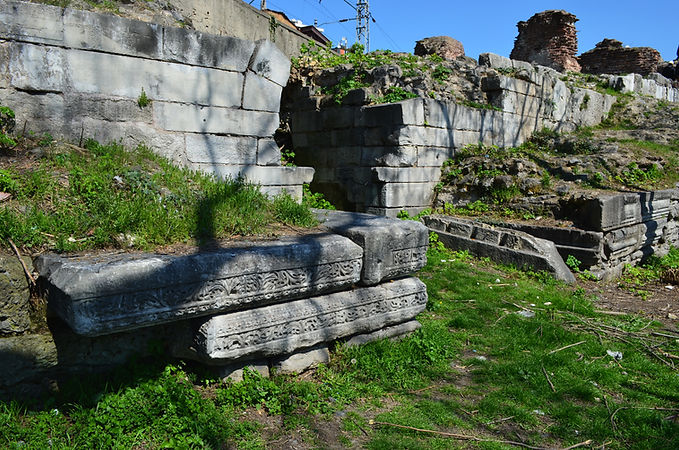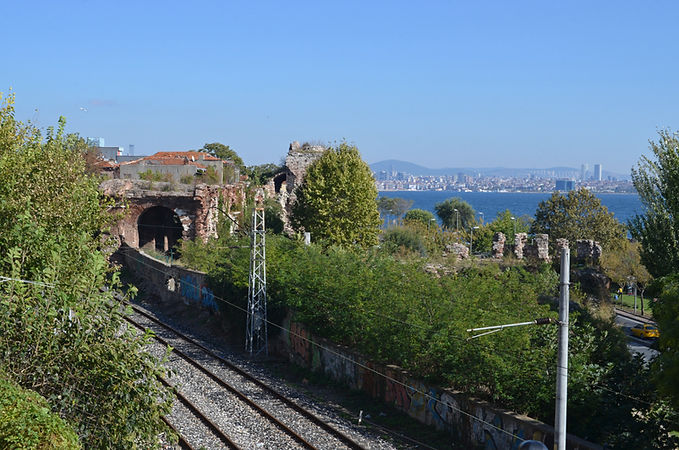The Palace of Boukoleon (literally “bull lion”) was on the shore of the Propontis (the Sea of Marmara), south of the Great Palace and the Hippodrome and east of the Church of Sts. Sergius and Bacchus in Constantinople. The first building phase of the palace complex is attributed to the emperor Theodosius II (408-450).
The Palace of Boukoleon, which overlooked the Propontis, had its own harbor (the limen of Boukoleon) with a flight of marble steps leading down to the emperor’s ship. It took its name from an ancient statue located at the harbor depicting colossal figures of a lion attacking a bull. It is not known when the statue of the lion and bull was brought to the site, though it is known to have survived until the 16th century. A tower once used as a lighthouse is located on the sea walls to the east.
Other palaces were in the vicinity, including the Palace of Hormisdas built during the reign of Constantine and later restored by Justinian, who used it as his palace before coming to power. This palace is often associated with the Palace of Boukoleon. It was extensively restored during the reign of Theophilos (829-842). Later Nikephoros II Phokas (963-969) erected walls around the Great Palace, transforming it into a fortress. This resulted in the Palace of Boukoleon being integrated within the complex of the Great Palace.
Isaac II Angelos was briefly imprisoned in dungeons beneath the Palace of Boukoleon after being blinded. The Stone of Unction (a marble slab on which Christ’s body laid after his crucifixion) was transferred to Constantinople from the Church of St John in Ephesus by order of Manuel I (1143-1180), who personally helped to carry it in procession from the harbor of Boukoleon to the Pharos Church of the Great Palace. The first Latin emperor, Baldwin of Flanders, settled in the Palace of Boukoleon, in which the marriage feast of Henry of Flanders and Agnes, daughter of Boniface of Montferrat, was celebrated in 1207. When Boniface of Montferrat (future king of Thessaloniki) first came to the palace, many Byzantine ladies had taken refuge in the palace, including Margaret of Hungary (wife of Isaac Angelos and his future wife) and Agnes of France (daughter of Louis VII and wife to both Alexios II Komnenos and Andronikos I Komnenos). The palace was also the residence of some of his successors. As the Palace of Blachernai became more important than the Great Palace, the Palace of Boukoleon also lost its importance and was finally abandoned by the Late Byzantine era.
The remains of the Palace of Boukoleon can be found south of the Hippodrome. Sections of the palace were destroyed to build a railway, though a vaulted structure with three large marble-framed windows and a gateway have survived. While situated on the waterfront, the shallow waters by the maritime walls were filled in so as to build a new road, Kennedy Caddesi, in 1959. Two stone lions at the Istanbul Archaeological Museum, probably dating to the 6th century, once stood on remnants of the palace, overlooking the harbor. Beneath the palace east of the imperial staircase is a cistern. It has a trapezoidal plan with six columns with Ionic capitals dating to the 6th century. It has been suggested that the cistern dates to the 9th century, though this is uncertain.

Photo by Guillaume Berggren



Empress Zoe addresses sailors from Boukoleon Palace
From the 12th century manuscript the Madrid Skylitzes in Biblioteca Nacional de España

Seaward Walls of Constantinople and remains of Boukoleon Palace (c.1850)

“Tower of Belisarius” and the Church of Sergius and Bacchus

Plan by Mamboury
Istanbul Archaeological Museums
Lions from Boukoleon Palace
Late Roman-Early Byzantine
Icon of an angel
Architectural fragments from the Palace of Boukoleon
Architectural fragments from the Palace of Boukoleon
Architectural fragments from the Palace of Boukoleon


Istanbul Archaeological Museums
From Bode Museum (No. 3237)
Lions in the Garden of the Great Palace Mosaic Museum
Sources
Byzantine Constantinople: Monuments, Topography and Everyday Life edited by Nevra Necipoğlu
Bildlexikon zur Topographie Istanbuls: Byzantion, Konstantinupolis, Istanbul by Wolfgang Müller-Wiener
Constantinople: Capital of Byzantium by Jonathan Harris
İstanbul'da Bizans Dönemi Sarnıçlarının Mimari Özellikleri ve Kentin Tarihsel Topografyasındaki Dağılımı by Kerim Altuğ
The Crusades Classic Histories Series: The War Against Islam 1096-1798 by Malcolm Billings
The Pantokrator Monastery in Constantinople edited by Sofia Kotzabassi
Oxford Dictionary of Byzantium edited by Alexander Kazhdan
The Oxford Handbook of Byzantine Studies edited by Jeffreys, Haldon and Cormack
Resources
Palace of Boukoleon Album (Byzantine Legacy Flickr)





































